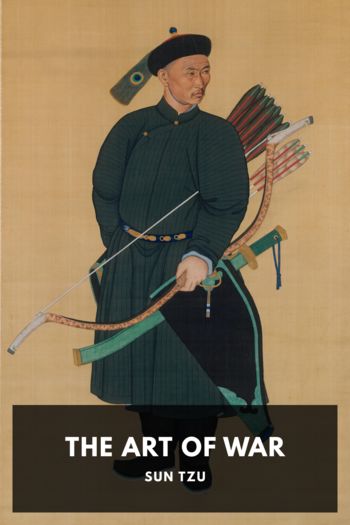The Art of War by Sun Tzu (elon musk reading list TXT) 📕

- Author: Sun Tzu
Book online «The Art of War by Sun Tzu (elon musk reading list TXT) 📕». Author Sun Tzu
Hsiang Liang used to instruct his nephew Chi152 in the art of war. Chi got a rough idea of the art in its general bearings, but would not pursue his studies to their proper outcome, the consequence being that he was finally defeated and overthrown. He did not realize that the tricks and artifices of war are beyond verbal computation. Duke Hsiang of Sung153 and King Yen of Hsü154 were brought to destruction by their misplaced humanity. The treacherous and underhand nature of war necessitates the use of guile and stratagem suited to the occasion. There is a case on record of Confucius himself having violated an extorted oath,155 and also of his having left the Sung State in disguise.156 Can we then recklessly arraign Sun Tzǔ for disregarding truth and honesty?157
BibliographyThe following are the oldest Chinese treatises on war, after Sun Tzǔ. The notes on each have been drawn principally from the 西庫全書簡明目錄 Ssǔ kʽu chʽüan shu chien ming mu lu, ch. 9, fol. 22 sqq.
吳子 Wu Tzǔ, in 1 chüan or 6 篇 chapters. By 吳起 Wu Chʽi (d. 381 BC). A genuine work. See Shih Chi, ch. 65.
司馬法 Ssǔ-ma Fa, in 1 chüan or 5 chapters. Wrongly attributed to 司馬穰苴 Ssǔ-ma Jang-chü of the 6th century BC. Its date, however, must be early, as the customs of the three ancient dynasties are constantly to be met within its pages.158 See Shih Chi, ch. 64.
The Ssǔ Kʽu Chʽüan Shu (ch. 99, f. 1) remarks that the oldest three treatises on war, Sun Tzǔ, Wu Tzǔ and Ssǔ-ma Fa, are, generally speaking, only concerned with things strictly military—the art of producing, collecting, training and drilling troops, and the correct theory with regard to measures of expediency, laying plans, transport of goods and the handling of soldiers159—in strong contrast to later works, in which the science of war is usually blended with metaphysics, divination and magical arts in general.
六韜 Liu Tʽao, in 6 chüan, or 60 chapters. Attributed to 呂望 Lü Wang (or Lü 尚 Shang, also known as 太公 Tʽai Kung) of the 12th century BC.160 But its style does not belong to the era of the Three Dynasties.161 陸德明 Lu Tê-ming (550–625 AD) mentions the work, and enumerates the headings of the six sections, 文, 武, 虎, 豹, 龍 and 犬, so that the forgery cannot have been later than Sui dynasty.
尉繚子 Wei Liao Tzǔ, in 5 chüan. Attributed to Wei Liao (4th cent. BC), who studied under the famous 鬼谷子 Kuei-ku Tzǔ. The 漢志, under 兵家, mentions a book of Wei Liao in 31 chapters, whereas the text we possess contains only 24. Its matter is sound enough in the main, though the strategical devices differ considerably from those of the Warring States period.162 It is been furnished with a commentary by the well-known Sung philosopher 張載 Chang Tsai.
三略 San Lüeh in 3 chüan. Attributed to 黃石公 Huang-shih Kung, a legendary personage who is said to have bestowed it on Chang Liang (d. 187 BC) in an interview on a bridge.163 But here again, the style is not that of works dating from the Chʽin or Han period. The Han Emperor Kuang Wu (25–57 AD) apparently quotes from it in one of his proclamations; but the passage in question may have been inserted later on, in order to prove the genuineness of the work. We shall not be far out if we refer it to the Northern Sung period (420–478 AD), or somewhat earlier.164
李衛公問對 Li Wei Kung Wên Tui, in 3 sections. Written in the form of a dialogue between Tʽai Tsung and his great general 李靖 Li Ching, it is usually ascribed to the latter. Competent authorities consider it a forgery, though the author was evidently well versed in the art of war.165
李靖兵法 Li Ching Ping Fa (not to be confounded with the foregoing) is a short treatise in 8 chapters, preserved in the Tʽung Tien, but not published separately. This fact explains its omission from the Ssǔ Kʽu Chʽüan Shu.
握奇經





Comments (0)